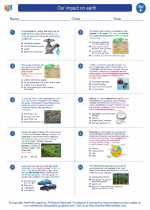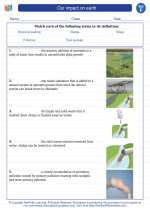Our impact on earth -> grassland
Grasslands
A grassland is a biome characterized by extensive open areas dominated by grasses and other herbaceous plants. There are two main types of grasslands: tropical and temperate. Grasslands are found on every continent except Antarctica and are important ecosystems that support a diverse range of plant and animal species.
Characteristics of Grasslands
- Grasslands are dominated by grasses and other herbaceous plants, with few trees and shrubs.
- They are typically found in areas with semi-arid to semi-humid climates.
- Grasslands are home to a variety of grazing animals, such as bison, gazelles, and zebras.
- They are susceptible to fires, which play a crucial role in maintaining the ecosystem.
Tropical Grasslands
Tropical grasslands, also known as savannas, are found in regions near the equator with distinct wet and dry seasons. They are characterized by tall grasses and scattered trees, and support a wide range of wildlife, including elephants, lions, and giraffes.
Temperate Grasslands
Temperate grasslands are found in regions with cold winters and hot summers. They are dominated by short and tall grasses and are home to grazing animals like bison, pronghorn, and deer. These grasslands are often converted for agricultural use due to their fertile soils.
Study Guide
- What are the two main types of grasslands?
- What are the main plant species that dominate grassland ecosystems?
- Describe the climate typically associated with grasslands.
- Explain the role of fire in maintaining grassland ecosystems.
- Compare and contrast tropical and temperate grasslands in terms of their characteristics and the wildlife they support.
- Discuss the human impact on grasslands and the challenges they face.
Remember to study the unique characteristics of each type of grassland and the ecological importance of these diverse ecosystems.
.◂Science Worksheets and Study Guides Sixth Grade. Our impact on earth

 Worksheet/Answer key
Worksheet/Answer key
 Worksheet/Answer key
Worksheet/Answer key
 Worksheet/Answer key
Worksheet/Answer key
 Vocabulary/Answer key
Vocabulary/Answer key
